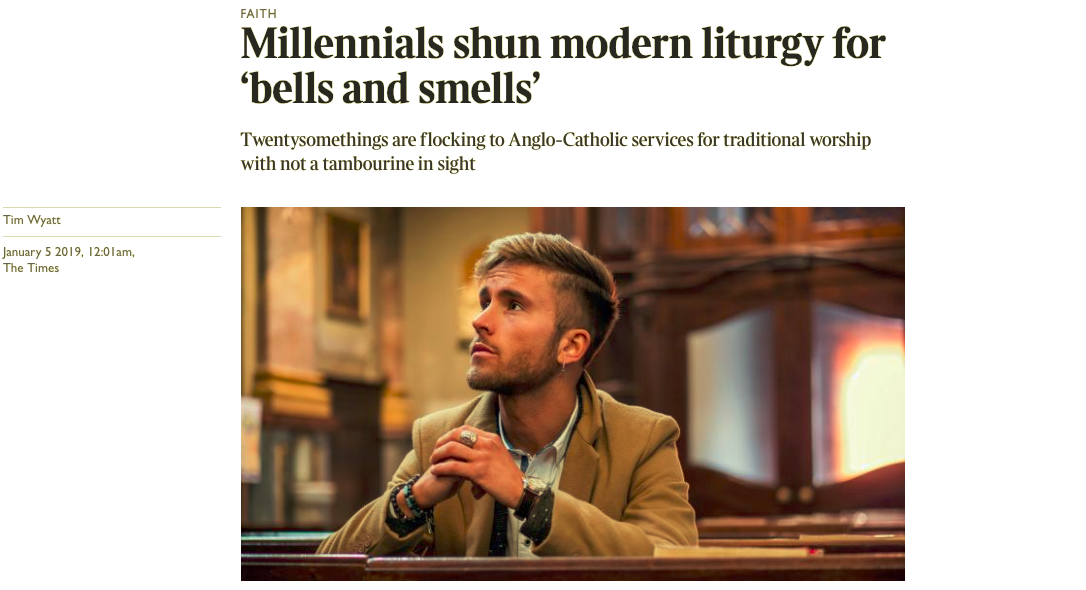January 7, 2019
Some reasons why Millennials should get into traditional liturgy (and some reasons why they shouldn’t)

Contemporary is out. Liturgy is the new black.
A recent article in The Times confirms what I’ve been hearing anecdotally, and been witnessing among our own congregation: many Millennials returning to church are often not headed towards the large pentecostal churches, or the “pentecostal-lite”, or even the “evangelical-lite”, but towards liturgy.
Now the article above is from the UK, but the same desire for something more, something deeper, something that links to the faith of the past, is still there. Indeed, it’s evident that this resurgence is a reaction to the increasingly vacuous secular frame many Millennials (and others) are experiencing in modern life.
The modern promises, tethered to a post-Christian progressivism that promises utopia “just over the next rise in the road”, are proving to be flaky. And just what did happen to that era where there would be no saints versus sinners, or those who were the untouchables, or the high priests who determined what was right and wrong?
The categories stayed the same, it’s just that the church no longer owned the language in the public square. Millennials have watched the cultural-fallen fail to find any place of atonement or redemption in an increasingly hostile world Once you sin you are out – and out for good.
What if that happens to me?, they’re thinking. So they’re not buying a future of peace and love when the only pathway being offered is one of cultural war and hate, and a redemptionless existence for the cultural transgressors.
In light of that many are turning towards the once lampooned liturgically-based churches and church services, where the emphasis is not on how much “this looks like a night club except we’ve got Jesus too”, and more on how different it looks.
Mind you, look at the sub-heading of that article above. When was the last time you saw an actual tambourine used in church, unless it was part of the kids’ play box in the creche?
That comment alone shows how disconnected the average secular well-educated Pom (or Aussie) is with Christianity. Tambourines went out with the ark (well, two tambourines went into the ark, and a whole drum kit came out).
So why are Millennials returning to liturgy and “bells and smells”? The Times reports:
Several said they relished the connection to past generations of believers through reciting the Book of Common Prayer, which English Christians have been using since 1549. Others valued the beauty and history of the choral music and Shakespearean liturgy. They were not simply “young fogeys”, they insisted.
A sense of history (I would argue a sense of meaning in history) and beauty.
Not bad things in and of themselves. And good reasons to return to liturgy. But not good reasons in and of themselves. Meaningful history and transcendent beauty might be at the basis of the Christian frame, but they can be aped by many a secularist, if tried hard enough.
Which is why we should offer a word of caution to Millennials who are seeking to capture something of the past. The article points out that robust, correct theology is often not a serious driver among a cohort who, having done the reconstructed hipster thing, (and handcrafted their own chopping boards on a belt lathe in the process) have moved on to the “young fogeys” stage:
There are also a fair number of “young fogeys” among the millennials who are returning to church. Their interest seems driven as much by traditionalism for its own sake as by faith. One of the recently baptised at St Bartholomew’s said that he felt a “duty” to preserve the cultural heritage and patrimony of established Christianity, “regardless of the theology”.
Careful there! If cultural preservation is the primary reason for a return to liturgy then we should be careful. There’s a good chance that in the current churn of the cultural wars, with the desire among some for what I call “Christendom without Christ”, that church liturgy could be linked in an unhealthy way to nationalism.
Now I don’t have a problem with nationalism per se (after all if the alternative is an amorphous pan-nationalism that merely suits the elites who wish to unencumbered in their pursuits by something as frivolous as a passport), but I don’t want the church to be subsumed by it (again) in such a way that the culture and the church become indivisible. That’s a project that only Jesus is permitted to undertake, and when he does it will look very different to what we think it will.
For me, theology – and what it leads to – is the primary reason to get into liturgy. And, ironically, good theology will lead us away from many a sin, including the sin of putting too much hope in nationalism. Paul tells Timothy “watch your life and doctrine closely“, and I assume he believes there is a causal link between the two!
Liturgy, when done well, embeds words and ideas in your head over time that make their way to your heart (take a bow James KA Smith) and changes you! The point of all liturgies is to shape you towards something, to make you love something through practice over time.
And in this distracted, dishevelled generation, there’s precious little of anything that lasts over time. Precious few experiences, or products that are not designed to be superseded, or that have redundancy built in to them. Good liturgy grounded in good doctrine will aid in the rebuilding program over time that our church culture desperately needs.
What we don’t need is just another case of style over substance. I well remember fifteen years ago reading one critic of the emerging church saying that if the only point was to replace Boomer-led seeker services with hipster candles and darkened rooms, then we’ve just swapped one form of consumerism for another. Time has proven this to be the case.
Where are the theological robust hordes of fifty somethings who went through the emergent church and all of its new liturgical forms? Far too many of them used that as a way out the door altogether. They’ve certainly proven to be cultural assimilators to the new Sexular Culture that has swamped those early emerging church enthusiasts and leaders. We don’t want another round of that, do we?
So what should liturgy primarily drive you to? The past? Yes, but with a catch. And the catch is the future. Two futures, in fact.
The first future is the ongoing historical future of this age. Liturgy done well can navigate us through the web of lies, fake news, beguiling counter-narratives and rejections of the transcendent that are like sulphuric acid for the soul. It can ground us in something historical in the past that matters now, not simply because the liturgy matters now, but because the Lord of the liturgy matters now.
As Smith points out, the cultural liturgies of our day “want our hearts”, and we need to guard our hearts from the everyday cultural practices through other liturgies (and yes that means daily prayer and reading of Scripture too. And no, I don’t mean that preaching the Word weekly is not important).
But the other future is the eschatological future of the age to come. Who has not said the Apostles’ Creed together in church and not wondered at the truth of these words?:
On the third day he rose again;
he ascended into heaven,
he is seated at the right hand of the Father,
and he will come to judge the living and the dead.
I believe in the Holy Spirit,
the holy catholic Church,
the communion of saints,
the forgiveness of sins,
the resurrection of the body,
and the life everlasting. Amen.
Who has ever said those words publicly with God’s people, without focussing on the fact that one day the clouds will indeed part – or whatever it actually means for the space of God to invade fully the space of this world – and Jesus will return as king? It should sober us, drive us from sin, drive us to Him.
Good liturgy does not announce that actually we’re all here on earth to usher in God’s kingdom through the good works that we do, and that somehow Jesus’ return is a minor part of the schema, and which we probably wouldn’t recognise it if it happened, and which could be somewhat of an irritation to our plans.
Good liturgy shuns all of that progressive, liberal agenda that sees the return of Jesus as a adendum to what we are doing, as if when he returns we can say “We’ve got this Jesus”.
While good liturgy, lived out, does not preclude us getting on with living godly, holy, selfless lives in this age, – indeed it presupposes that it what it is doing – it also helps us put our hopes in the cataclysmic age-to-come, an age that will be ushered in at the Parousia.
He will come to judge the living and the dead. In an age of instant online judgement, Jesus will sweep away all pretenders to the throne, no matter how many Twitter or Instagram likes they get.
So much good liturgy focuses on death and resurrection – His and ours! It reminds us of our mortality, our sinfulness, our constant need of forgiveness, and the locus of our hope.
If good liturgy shapes Millennials towards the age-to-come, rather than simply being something they use to further craft their already well-crafted lives in this age, then so much the better. But if it’s just another round of faddishness, then it, like much of the emerging church effort at liturgy before it, will simply fade away or be assimilated culturally.
Let’s hope and pray for something better this time around.
Written by
There is no guarantee that Jesus will return in our desired timeframe. Yet we have no reason to be anxious, because even if the timeframe is not guaranteed, the outcome is! We don’t have to waste energy being anxious; we can put it to better use.
Stephen McAlpine – futureproof
Stay in the know
Receive content updates, new blog articles and upcoming events all to your inbox.


